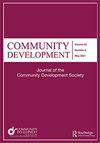Editorial
IF 1.3
Q3 DEVELOPMENT STUDIES
引用次数: 0
Abstract
In this issue of Community Development readers are introduced to eight papers that together present a diverse, yet vivid illustration of the challenges, opportunities, and innovations that characterize development in rural communities. The challenges described throughout the papers largely point to the precarious balance between responding to global economic pressures while retaining clear identities and authentic senses of place. Among the opportunities highlighted in the issue is the promise of placebased enterprises and marketscapes as bridges between rurality and external consumption demands and trends that include, for example, local food and sustainable tourism. Readers, whether community development practitioners or scholars, are likely to find inspiration and guidance from the rural development innovations that emerge from the issue, whether that be a creative approach to overcoming the economic fallout of the COVID-19 pandemic or centering place-based mystique as a tool for community identity work. Below the landscape of the issue is described in greater detail. Using the local food movement in the U.K. as an empirical setting, Curry’s paper contributes a constructive critique of the shortcomings of neoclassical economic philosophies and mechanisms on community development initiatives. In doing so, Curry proposes a set of market mechanisms and social innovations, such as inter-firm collaboration and systemic coordination, that may be useful in maximizing the positive influence of marketization on community development goals and initiatives. Such influence is particularly promising in rural communities and economies that are often confronted with stagnated market conditions and declining populations via urbanization. Currie and colleagues further address the influence of large-scale economic policy conditions, specifically neo-liberalism, on rural community development. They identify the complexities as well as reveal the potential power of including diverse stakeholder groups in initiating and enacting community-centered resiliency planning. Petric and Gibson further underscore these economic-based challenges in their study of community investment fund strategies within rural Canadian regions and the associated reliance on government investments in public awareness campaigns and engagement strategies. Indeed, rural community member engagement in innovative development strategies is a notable challenge. Theodori, Willits, and Fortunato aptly illustrate this reality in their examination of the influence of mystique on rural community attachment and engagement. Their findings reveal the nuance of rural community identity with subjects positively associating mystique with community attachment, community satisfaction, and community decision-making. Yet, they find such association is not statistically associated with community-oriented action. Given recent upticks in cravings for nostalgia, especially via consumption choices, Theodori, et al.’s findings point to the potential, yet largely untapped power of strategically engaging cultural and societal trends in ways that bolster community development, engagement, and transformation. Next, Sanders, Lamm, and COMMUNITY DEVELOPMENT 2023, VOL. 54, NO. 2, 155–156 https://doi.org/10.1080/15575330.2023.2195695社论
本期《社区发展》向读者介绍了八篇论文,它们共同生动地阐述了农村社区发展所面临的挑战、机遇和创新。整篇论文所描述的挑战主要指向在应对全球经济压力的同时保持清晰的身份和真实的地方感之间的不稳定平衡。该问题强调的机会之一是,基于地点的企业和市场前景有望成为农村与外部消费需求和趋势之间的桥梁,其中包括当地食品和可持续旅游。无论是社区发展从业者还是学者,读者都有可能从这一问题产生的农村发展创新中找到灵感和指导,无论是克服COVID-19大流行的经济影响的创造性方法,还是将基于地方的神秘感作为社区认同工作的工具。下面更详细地描述了这个问题的概况。Curry的论文以英国的本地食品运动为实证背景,对新古典经济哲学和机制在社区发展倡议方面的缺陷进行了建设性的批评。在此过程中,库里提出了一套市场机制和社会创新,如企业间合作和系统协调,这可能有助于最大化市场化对社区发展目标和倡议的积极影响。这种影响在农村社区和经济中尤其有希望,因为农村社区和经济往往面临市场停滞和城市化导致的人口减少的问题。Currie及其同事进一步探讨了大规模经济政策条件,特别是新自由主义对农村社区发展的影响。他们确定了复杂性,并揭示了在启动和制定以社区为中心的弹性规划时,包括不同利益相关者群体的潜在力量。peter和Gibson进一步强调了这些基于经济的挑战,他们研究了加拿大农村地区的社区投资基金策略,以及在公众意识运动和参与策略中对政府投资的相关依赖。事实上,农村社区成员参与创新发展战略是一项显著挑战。西奥多里、威利茨和福尔图纳托在研究神秘感对农村社区依恋和参与的影响时,恰当地说明了这一现实。他们的研究结果揭示了农村社区认同的细微差别,被试正将神秘感与社区依恋、社区满意度和社区决策联系起来。然而,他们发现这种联系在统计上与社区导向行动并不相关。鉴于最近对怀旧的渴望有所上升,特别是通过消费选择,Theodori等人的发现指出了潜在的,但很大程度上尚未开发的战略力量,以促进社区发展,参与和转型的方式参与文化和社会趋势。下一步,桑德斯,拉姆,和社区发展2023,卷54,NO。2,155 - 156 https://doi.org/10.1080/15575330.2023.2195695
本文章由计算机程序翻译,如有差异,请以英文原文为准。
求助全文
约1分钟内获得全文
求助全文
来源期刊

Community Development
DEVELOPMENT STUDIES-
CiteScore
2.60
自引率
30.80%
发文量
62
期刊介绍:
Community Development is the peer-reviewed journal of the Community Development Society. Community Development is devoted to improving knowledge and practice in the field of purposive community change. The mission of the journal is to advance critical theory, research, and practice in all domains of community development, including sociocultural, political, environmental, and economic. The journal welcomes manuscripts that report research; evaluate theory, methods, and techniques; examine community problems; or critically analyze the profession itself. Articles may address current issues including the environment and sustainability; food systems; land use; poverty; race, ethnicity, and gender; participation and social justice; economic development; health; housing; and other important topics impacting the field.
 求助内容:
求助内容: 应助结果提醒方式:
应助结果提醒方式:


